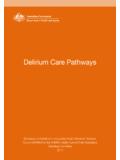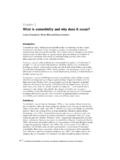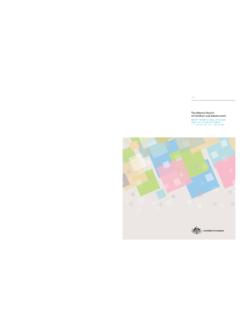Transcription of Requirements for the Retention of Laboratory Records and ...
1 NATIONAL PATHOLOGY ACCREDITATION ADVISORY COUNCIL Requirements FOR THE Retention OF Laboratory Records AND DIAGNOSTIC material (S eventh edition 2018) NPAAC Tier 3B Document ii Requirements for the Retention of Laboratory Records and Diagnostic material Print ISBN: 978-1-76007-342-8 Online ISBN: 978-1- 76007-341-1 Publications approval number: 12115 Copyright 2018 Commonwealth of Australia as represented by the Department of Health This work is copyright. You may copy, print, download, display and reproduce the whole or part of this work in unaltered form for your own personal use or, if you are part of an organisation, for internal use within your organisation, but only if you or your organisation: (a) do not use the copy or reproduction for any commercial purpose; and (b) retain this copyright notice and all disclaimer notices as part of that copy or reproduction.
2 Apart from rights as permitted by the Copyright Act 1968 (Cth) or allowed by this copyright notice, all other rights are reserved, including (but not limited to) all commercial rights. Requests and inquiries concerning reproduction and other rights to use are to be sent to the Communication Branch, Department of Health, GPO Box 9848, Canberra ACT 2601, or via e-mail to First published 1987 Second edition 1998 Third edition 2002 Fourth edition 2007 (formerly titled: Retention of Laboratory Records and Diagnostic material ) Fifth edition 2009 reprinted with amendments Sixth edition 2013 reprinted and reformatted to be read in conjunction with the Requirements for Medical Pathology Services Seventh edition 2018 revised and reprinted Australian Government Department of Health Requirements for the Retention of Laboratory Records and Diagnostic material iii Contents Abbreviations.
3 Vi Definitions .. vii Introduction ..1 1. Conditions of Specimen Storage ..5 2. Minimum Retention Times ..6 Discipline 6 3. Tracking of Referred and Received Specimens ..16 4. Disposal of Specimens and Records ..17 5. Impact of Amalgamation, Mergers or Change of Ownership ..18 Appendix A Returning a Specimen or Body Part to a Patient (Informative) ..19 Returning a specimen to a patient or next-of-kin .. 19 Returning a body part .. 19 Returning a processed specimen .. 20 Appendix B Notice of Information Technology (IT) Requirements under the Electronic Transactions Act 1999 for scanning and storage of referrals and requests (Normative) ..21 Appendix C Legislation relating to the Retention and disposal of Laboratory Records and diagnostic materials (Informative) ..23 References ..24 Bibliography ..25 Acknowledgements ..26 Further iv Requirements for the Retention of Laboratory Records and Diagnostic material The National Pathology Accreditation Advisory Council (NPAAC) was established in 1979 to consider and make recommendations to the Australian, state and territory governments on matters related to the accreditation of pathology laboratories and the introduction and maintenance of uniform standards of practice in pathology laboratories throughout Australia.
4 A function of NPAAC is to formulate Standards and initiate and promote education programs about pathology tests. Publications produced by NPAAC are issued as accreditation material to provide guidance to laboratories and accrediting agencies about minimum Standards considered acceptable for good Laboratory practice. Failure to meet these minimum Standards may pose a risk to public health and patient safety. Requirements for the Retention of Laboratory Records and Diagnostic material v Scope The Requirements for the Retention of Laboratory Records and Diagnostic material (Seventh edition 2018) is a Tier 3 B NPAAC document and must be read in conjunction with the Tier 2 document Requirements for Medical Pathology Services. The latter is the overarching document broadly outlining standards for good medical pathology practice where the primary consideration is patient welfare, and where the needs and expectations of patients, Laboratory staff and referrers (both for pathology requests and inter- Laboratory referrals) are safely and satisfactorily met in a timely manner.
5 Whilst there must be adherence to all the Requirements in the Tier 2 document, reference to specific Standards in that document are provided for assistance under the headings in this document. The Requirements for the Retention of Laboratory Records and Diagnostic material represents the minimum standards for Retention of Laboratory Records and materials. These principles are important for medical pathology services. Individual laboratories may choose to exceed these minimum Requirements based on local circumstances and historical practice. This document does not address tissue banking, biobanking or issues related to research Records and specimens in research laboratories. vi Requirements for the Retention of Laboratory Records and Diagnostic material Abbreviations Abbreviation Description AS Australian Standard ISO International Organization for Standardization NPAAC National Pathology Accreditation Advisory Council NATA National Association of Testing Authorities, Australia NIPT Non-invasive Prenatal Testing TGA Therapeutic Goods Administration Requirements for the Retention of Laboratory Records and Diagnostic material vii Definitions Term Definition Requirements for Medical Pathology Services (RMPS) means the overarching document broadly outlining standards for good medical pathology practice where the primary consideration is patient welfare, and where the needs and expectations of patients, Laboratory staff and referrers (both for pathology requests and inter- Laboratory referrals) are safely and satisfactorily met in a timely manner.
6 Viii Requirements for the Retention of Laboratory Records and Diagnostic material This page is intentionally blank Requirements for the Retention of Laboratory Records and Diagnostic material 1 Introduction Pathology reports form part of the patient s medical record , and may also be retained in, or remain accessible from, the Laboratory information system. In addition, laboratories are required to maintain a number of Records that substantiate the validity of testing done for the production of results for patient Records . Retaining specimens has two primary purposes: to ensure there is a physical audit trail, in case the integrity or identification of the specimen needs to be established; and to allow additional testing to be done on the original specimen, if required. In some cases, the original specimen may be consumed, exhausted or be otherwise unsuitable for any additional testing; however, Retention is still required for audit and traceability purposes.
7 If a specimen subject to Retention Requirements is requested by another Laboratory ( for a second opinion or additional testing), both original and reference laboratories have an obligation to track the location of the specimen and ensure its safe return to the source Laboratory . The Requirements for the Retention of Laboratory Records and Diagnostic material (Seventh edition 2018) outlines the minimum best practice standards for Retention of Laboratory Records and materials. These principles have been developed with a risk-based approach and are important for medical pathology services to assure they provide high quality pathology services. The overarching priority in the development of NPAAC Standards is patient welfare. However in relation to the issue of Retention of specimens and Laboratory Records , a balance needs to be achieved between the possible requirement to retrieve materials to inform health decisions for a patient and/or their family (clinical utility), and issues related to prolonged storage.
8 material with implications for the long-term health of an individual or their family members (such as Records relating to germline genetic testing) may be required to be stored for longer. Representation has been made to NPAAC by various advocacy groups that are particularly concerned at the reduction in minimum storage times for histology blocks from adult patients from 20 years to 10 years in the previous version of the Requirement for the Retention of Laboratory Records and Diagnostic material (Sixth edition , 2013). The issue has been considered by the Drafting Committee, with input sought from professional groups, researchers and consumer representatives, and a decision has been made to not reverse the previous reduction in minimum storage times for histology specimens from adults. The reasoning behind this decision is as follows: This NPAAC Standard relates to minimum storage times for routine specimens; individual laboratories may choose to exceed these storage times if the capacity to do so and clinical justification exists.
9 It should be noted that the Standard has not altered the requirement to retain histology specimens from a paediatric patient at least until the age of 25 (majority plus 7 years) or until the minimum period has elapsed (whichever is greater), thus for practical reasons, laboratories may choose to retain all specimens as if they were of paediatric origin. 2 Requirements for the Retention of Laboratory Records and Diagnostic material The Standard does not address issues relating to research laboratories or Tissue Banking, which are covered by other documents.*1,2 Tissue specimens that may have been sub-optimally fixed, processed or stored, and that lack detailed clinical and follow-up information are of limited value as research Despite recent advances in the ability to extract meaningful genetic information from archival tissue specimens through the use of using next generation sequencing techniques, similar techniques have highlighted tumour heterogeneity and clonal evolution during tumour progression.
10 Testing of an archival specimen (although theoretically possible) is not necessarily a reliable predictor of the therapeutic response of disease recurrence, which in nearly all cases would be amenable to biopsy for accurate biomarker assessment and individualised treatment planning. Therefore, assessment of archival tumour material becomes largely a matter of academic interest rather than clinical utility, and the value of comparing previous with current tumour samples in very occasional cases must be weighed against the impost of retaining all adult histology samples for prolonged periods. Triage of cases for prolonged Retention on the basis of diagnosis alone cannot be justified; the requirement for review and retesting is not limited to tumour samples, and indeed, in very antiquated samples, a request for retrieval is more likely to be related to other indications such as identity/paternity testing.









